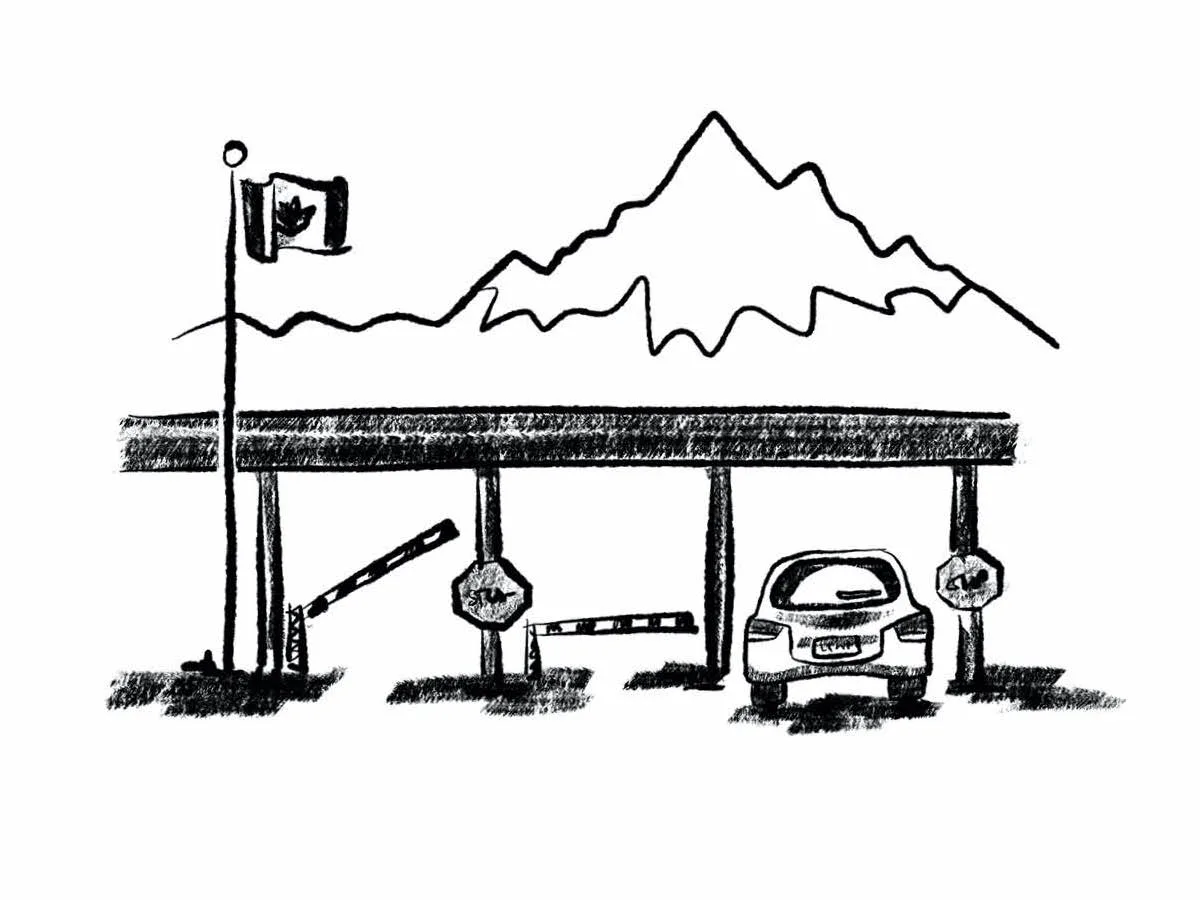
Image by Ivy Sanders Schneider

Image by Ivy Sanders Schneider
As a long-haired, brown-skinned Native man with an obviously Indian name, I have an easier time than most getting between the United States and Canada. Because I am a “status Indian,” legally registered with the Canadian government, I have special border-crossing rights under the Jay Treaty of 1794. The treaty is named for John Jay, the second governor of New York, who negotiated with Great Britain on behalf of the U.S. Most of its articles concern maintaining peace and promoting trade between the two countries. In the eighteenth century, powerful Indian nations still moved throughout North America, and the treaty reflects this fact. Article III granted Indians in both Canada and the U.S. the right “freely to pass and repass by land, or inland navigation, into the respective territories and countries of the two parties on the continent of America.”
There’s a line in a protest song beloved by the St’at’imc, my grandfather’s people, that goes:
Hey ya-ho, hey-ya, hey-yo-ho…
We didn’t cross the borders, the borders crossed us!
On this continent — as in much of the rest of the world — borders are arbitrary imperial inventions. The U.S.-Canada border, for example, was simply drawn across the 49th parallel, but was forced to make some awkward detours, as in the case of Vancouver Island, which sits both north and south of the latitude. To this day, many Native territories, fisheries, hunting grounds, and family lines stretch across both sides. As the Kahnawà:ke Mohawk anthropologist and political theorist Audra Simpson explains in Mohawk Interruptus, the Mohawks, and the broader Haudenosaunee Confederacy of which they are part, have long refused to recognize settler borders and settler sovereignty. In the early 1900s, a Mohawk ironworker from Kahnawà:ke crossed into the U.S. with his wife to live and labor in Philadelphia. When American authorities prosecuted him as an “illegal alien,” he insisted free passage was his birthright under the Jay Treaty and won the case.
Since then, the Haudenosaunee Nationals lacrosse team has traveled the world on Haudenosaunee passports; Mohawk ironworkers from Indian reserves like Kahnawà:ke and Ahkwesáhsne have built skyscrapers in American cities; Mohawk entrepreneurs have carried cigarettes and other goods across the border, flouting Canadian and American tax laws and tariffs. My father emigrated from British Columbia to New York in 1986 and has lived and worked in the United States, where I was born, ever since. He has never needed or sought American citizenship. Though I carry an American passport, I cross the border using my Canadian Indian status card, on principle. (Members of Indian tribes within U.S. borders do not have equivalent rights when traveling into Canada.) Every so often, I do get hassled by Border Patrol agents, who can be inconsistent in their requirements for proving status and ancestry. Still, in my experience, officials generally recognize the statutes of the Jay Treaty, if not the sensibilities of my ancestors, and let me go about my business on my land.
In Bremerton, the little Navy town in Washington state where I live, near the Canadian border, many of the newest immigrants hail from Guatemala. They’re easily identifiable in town, wearing their traditional textiles and fashions. They speak Mayan languages. And like my people, they’re Indigenous — by blood, if not also by speech, culture, and political affiliation. Some of them might be considered “illegal,” but their forebears have been on this continent a lot longer than the lines we call borders. If I have a right to live and work in this country as an Indigenous person from north of the border, shouldn’t that claim extend to the southern border as well? And if the law says otherwise, who and what is in the wrong: the people who have been working this land for hundreds and thousands of years, or the regime of national boundaries invented in the last couple centuries, imposed by a government and society made in the image of Europe?
Republicans — and a growing number of elected Democrats — are now marshaling the crude logic of nativism to transform the southern border into a heavily policed, militarized bulwark against brown and Indigenous migrants. But the truth of who does and does not belong and come from here — of Indigeneity, rather than nativism — points toward a more humane and enlightened way. Maybe someday, hopefully not too many generations from now, that way will prevail across the southern border, and all others.
Julian Brave NoiseCat is the director of Sugarcane, which won the directing award in the U.S. documentary competition at the 2024 Sundance Film Festival. His first book, We Survived the Night, will be published by Alfred A. Knopf in 2025.